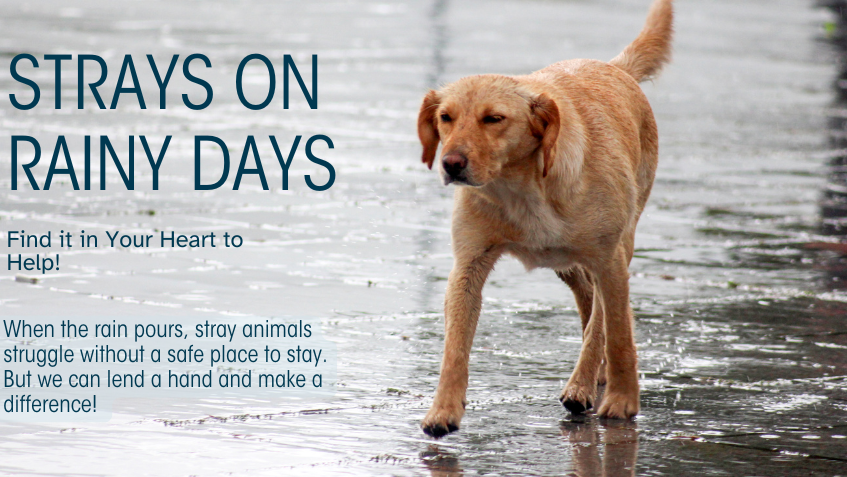Strays on Rainy Days – Find it in Your Heart to Help!
As raindrops patter against your window, creating a soothing symphony, it’s easy to cocoon yourself in the comfort of a warm home. But as you sip a hot drink and listen to the rain’s melodic rhythm, spare a thought for those without shelter — the countless stray animals seeking warmth and safety on rainy days. This blog post is a heartfelt appeal to recognize the plight of these vulnerable creatures and to find it in your heart to help.
Understanding the Stray Animal Crisis
The number of stray animals roaming our streets is staggering. Globally, millions of dogs and cats are left to fend for themselves. These animals face numerous challenges, including lack of food, exposure to harsh weather, disease, and the risk of being hit by vehicles. Rainy days exacerbate these difficulties, stripping them of the sparse comforts they can find on dry days.
Causes of Stray Populations
The reasons behind the high numbers of stray animals are multifaceted. Key factors include:
- Uncontrolled Breeding: Without spaying and neutering, animal populations can increase rapidly.
- Abandonment: Some pets are abandoned due to changes in their owners’ circumstances or because they were not prepared for the responsibility.
- Lack of Awareness: Many people are unaware of the plight of strays or how they can help.
The Impact of Rainy Weather on Strays
Rainy days pose specific challenges for stray animals. Here are some ways the wet weather affects them:
- Hypothermia and Illness: Cold, wet conditions can lead to hypothermia, especially for young, old, or sick animals. Wet fur can also exacerbate respiratory infections.
- Lack of Shelter: Strays often have limited access to dry, warm places to seek refuge from the rain.
- Scarcity of Food: Rain can wash away food sources, and fewer people are out to feed strays during storms.
- Increased Danger: Poor visibility and hazardous road conditions increase the risk of accidents involving stray animals.
How You Can Help Stray Animals
Understanding the challenges faced by stray animals is the first step toward making a difference. Here are several ways you can help:
- Support Local Shelters
Animal shelters and rescue organizations work tirelessly to provide refuge and care for stray animals. Supporting these organizations through donations, volunteering, or fostering can make a significant impact. Consider:
- Donating Supplies: Shelters often need food, bedding, and medical supplies.
- Volunteering Your Time: Help with daily tasks, fundraising events, or simply spending time with the animals.
- Fostering: Provide temporary homes for strays until they are adopted.
- Create Safe Spaces
If you notice stray animals in your area, consider creating safe spaces for them, especially during inclement weather. Some ideas include:
- Building Shelters: Simple structures made from plastic bins or crates can provide shelter.
- Providing Food and Water: Ensure that food is in a dry area and check water bowls frequently.
- Promote Spaying and Neutering
Preventing uncontrolled breeding is crucial in reducing stray populations. Encourage others to spay and neuter their pets and support programs that offer these services to stray animals and low-income pet owners.
- Educate Others
Raising awareness about the plight of stray animals is vital. Share information through social media, community events, or by talking to friends and family. Education can lead to more people taking action.
The Joy of Helping
Helping stray animals not only benefits them but can also enrich your life. Here are some rewards you may experience:
- Emotional Satisfaction: Knowing you’ve made a difference in an animal’s life is incredibly fulfilling.
- Companionship: Many people find lifelong friends in the animals they help.
- Community Building: Joining forces with others who care about animal welfare can foster a sense of community and purpose.
How Communities Can Make a Difference
Communities play a crucial role in addressing the stray animal crisis. Here are ways community efforts can make a significant impact:
Implementing Stray Animal Programs
Communities can develop and support programs aimed at reducing stray populations and improving animal welfare. These programs might include:
- Trap-Neuter-Return (TNR) Programs: Successful in many areas, these programs humanely trap, neuter, and return strays, reducing future populations.
- Adoption Events: Regularly held events increase the visibility of strays in need of homes.
- Educational Workshops: Informing the public about responsible pet ownership and the importance of spaying and neutering.
Leveraging Social Media
Social media platforms offer a powerful tool for raising awareness and coordinating efforts to help stray animals. By sharing posts about animals in need, community members can quickly mobilize support and resources.
Conclusion
Rainy days remind us of the comfort and safety we often take for granted. For stray animals, these days highlight their vulnerabilities and the urgent need for compassion and action. By supporting shelters, creating safe havens, promoting spaying and neutering, and educating others, we can make a meaningful difference in the lives of these animals.
Finding it in your heart to help stray animals can lead to rewarding experiences and positive changes in your community. Let the rain inspire you to take action, and together, we can create a world where every animal has the chance to feel safe, loved, and cared for.





